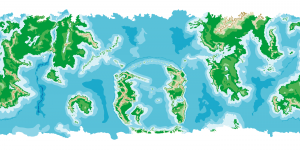Pacifica (Pacifica): Difference between revisions
mNo edit summary |
No edit summary |
||
| Line 8: | Line 8: | ||
| alt_names = Earth, Terra, Tellus <!--[[Terra (disambiguation)|Terra]], [[Terra (mythology)|Tellus]], [[Gaia hypothesis|Gaia]], [[Gaea]], the [[World]]--> | | alt_names = Earth, Terra, Tellus <!--[[Terra (disambiguation)|Terra]], [[Terra (mythology)|Tellus]], [[Gaia hypothesis|Gaia]], [[Gaea]], the [[World]]--> | ||
| adjectives = Pacifican, eartly, terran, tellurian | | adjectives = Pacifican, eartly, terran, tellurian | ||
| symbol = <!--[[File: | | symbol = <!--[[File:Astronomical symbols Pacifica.png|18px|Astronomical symbol of Pacifica]]--> | ||
| image = Pacifica Topographic No Legend 1.0.png | | image = Pacifica Topographic No Legend 1.0.png | ||
| image_alt = | | image_alt = | ||
Revision as of 17:21, 9 May 2023
 Topographic map of Pacifica | |
| Designations | |
|---|---|
| Earth, Terra, Tellus | |
| Adjectives | Pacifican, eartly, terran, tellurian |
Pacifica is the fifth planet from the Sun, situated in the Pacifica System.
Etymology
The Modern Austral word Pacifica developed from Old Austral Pācificus, borrowed from Late Pretian pāx (“peace, home”) + -facio (“to make”), pāxifacio (“to make home”). It is used to refer to the feeling of home in certain dialects in Pretian.
Geophysical characteristics
Size and shape
Pacifica has a rounded shape with an average diameter of 12,742 kilometers (7,918 mi), making it the sixth largest planetary sized and the second largest terrestrial object of the Pacifica System.
Tectonic plates
Pacifica's mechanically rigid outer layer of Pacifica's crust and upper mantle, the lithosphere, is divided into tectonic plates. The xx major plates are xx.
Orbit and rotation
Pacifica orbits the sun.
Pacifica–Min-Max system
Maxima
Also known as the Moon, Maxima is one of two natural satellite of earth.
Minima
Atmosphere
Weather and climate
Pacifica's atmosphere has no definite boundary, gradually becoming thinner and fading into outer space.